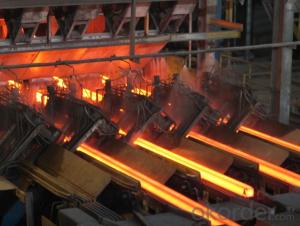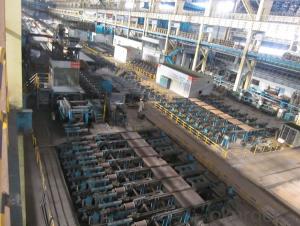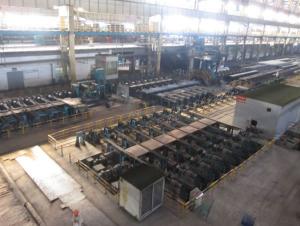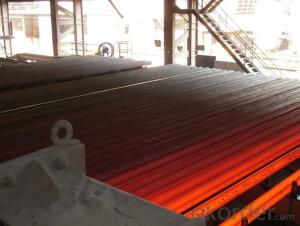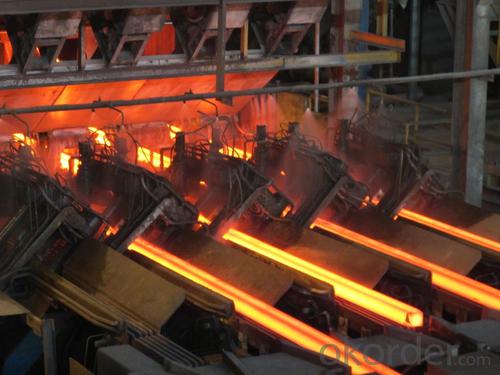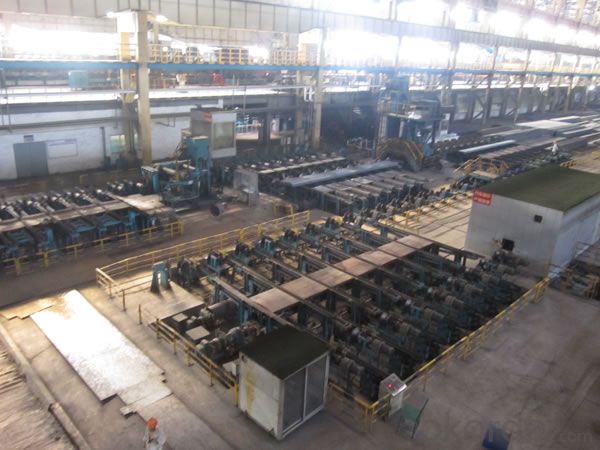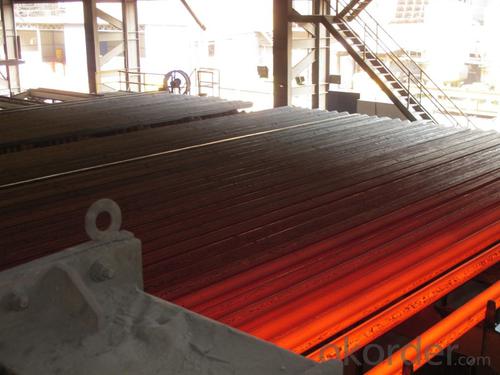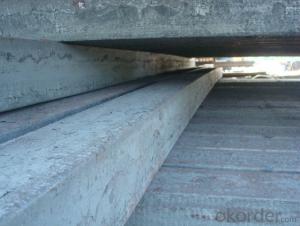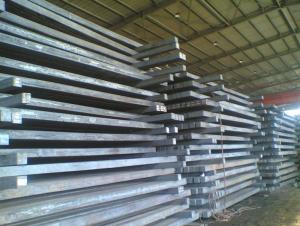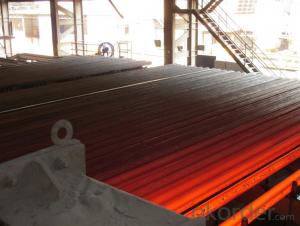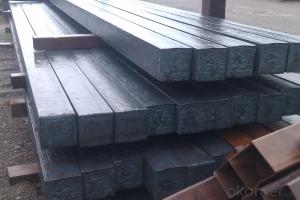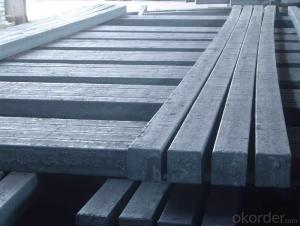Prime quality square alloy steel billet 85mm Q235
- Loading Port:
- Tianjin
- Payment Terms:
- TT OR LC
- Min Order Qty:
- 100 m.t.
- Supply Capability:
- 10000 m.t./month
OKorder Service Pledge
OKorder Financial Service
You Might Also Like
Structure of Prime quality square alloy steel billet 85mm Q235
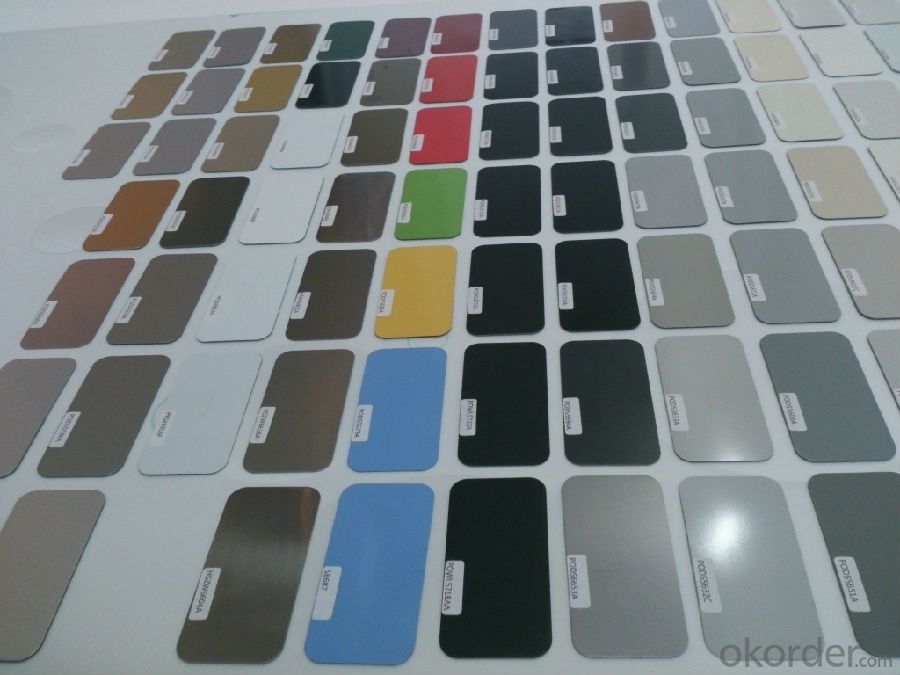
Description of Prime quality square alloy steel billet 85mm Q235
1. Prepainted steel coil is coated with organic layer, which provides higher anti-corrosion property and a longer lifespan than that of galvanized or galvalume steel sheets.
2. The base metals for prepainted steel coil consist of cold rolled, HDGI Steel, electro-galvanized and hot-dip alu-zinc coated steel. The finish coats of prepainted steel coil can be classified into groups as follows: polyester, silicon modified polyesters, polyvinylidene fluoride, high-durability polyester, etc.
3. The production process has evolved from one-coating-and-one-baking to double-coating-and-double-baking, and even three-coating-and-three-baking.
4. The color of the prepainted steel coil has a very wide selection, like orange, cream-colored, dark sky blue, sea blue, bright red, brick red, ivory white, porcelain blue, etc.
5. The prepainted steel coils can also be classified into groups by their surface textures, namely regular prepainted sheets, embossed sheets and printed sheets.

Main Feature of Prime quality square alloy steel billet 85mm Q235
Uncoated CR steel sheet
With the features of in line with the international highest standards in demension and shape, excellent surface finish and properties, the products are mainly used in home appliance and automobile industries.
Galvanized steel sheet(include HDG and EG)
With the features of good corrosion resistance, the products are mainly used in automobile, home appliance, electronics, building and machinery manufacture industries, etc.
Precoated steel sheet
With the features of enviromental protection and good processablility, long lasting surface durability, rich in colors, the products are maily used in building, home appliance and furniture industries, etc.
Applications of Prime quality square alloy steel billet 80mm Q235
Construction
Manufacture anticorrosion, industrial and civil architecture roof boarding, roof grille
Light industries
Home appliance's case, civil chimney, kitchen utensils
Auto industry
Corrosion resistant parts of cars
Agriculture
Food storage, meat and aquatic products' freezing and processing equipment
Commerce
Equipments to store and transport materials, and packing implements

Specifications of Prime quality square alloy steel billet 85mm Q235
Product | Prime quality square alloy steel billet 85mm Q235 |
Material Grade | SGCC / SGCH / DX51D+AZ, etc |
Thickness | 0.6-3.0mm |
Width | 500-1500mm |
Tolerance | Thickness: +/-0.02mm , Width:+/-2mm |
Zinc-coating | Z30-150g/m2 |
Technique | Raw material: Hot rolled steel coil --> Cold rolled_>hot dipped galvalume |
Surface | Dried, Chromated, Unoiled |
Spangle | Regular spangle , small spangle, zero spangle |
ID | 508MM 610MM |
Coil weight | 1-25MT |
Export package | Cardboard inner sleeves, Waterproof paper, galvanized steel covered and steel strip packed |
FAQ of Prime quality square alloy steel billet 85mm Q235
We have organized several common questions for our clients,may help you sincerely:
1. How Can I Visit There?
Our company is located in Tianjin City, China, near Beijing. You can fly to Tianjin Airport Directly. All our clients, from home or aboard, are warmly welcome to visit us!
2. How Can I Get Some Sample?
We are honored to offer you sample.
3. Why choose CNBM?
Our delivery time about 15-20days for standard sizes, if you have other requirements like hardness, quanity and width ,it is about 20-40days. But don't worry we also try our best for the delivery time ,because time longer and our cost is higher.
- Q: Are steel billets used in the manufacturing of construction machinery?
- Steel billets are a common choice for the manufacturing of construction machinery. They serve as semi-finished products, acting as raw materials across various industries, including construction machinery manufacturing. To create these billets, molten steel is cast into a solid form and then undergoes additional shaping and sizing processes. The high strength, durability, and versatility of steel billets make them well-suited for constructing robust components and structures in construction machinery. Examples of parts that can be manufactured using steel billets include chassis, frames, buckets, booms, and arms, among others. By utilizing steel billets, construction machinery becomes capable of withstanding the demanding conditions and heavy loads commonly encountered in construction projects.
- Q: What are the different surface treatments for improved wear resistance in steel billets?
- There are several surface treatments available to improve wear resistance in steel billets. These treatments are designed to enhance the durability and longevity of the steel, making it more resistant to wear and tear. One commonly used surface treatment is case hardening. This process involves heating the steel billets to a high temperature and then rapidly cooling them in a quenching medium, such as oil or water. This creates a hard outer layer on the steel, known as a case, while maintaining a relatively softer core. The hardened case provides excellent wear resistance, while the softer core maintains toughness and ductility. Another surface treatment for improved wear resistance is nitriding. This process involves introducing nitrogen into the surface of the steel billets, typically through a gas or plasma-based process. The nitrogen diffuses into the steel, forming a hard nitride layer on the surface. This nitride layer significantly increases the hardness and wear resistance of the steel, making it suitable for applications where high wear resistance is required. A third surface treatment option is hard chrome plating. In this process, a layer of chromium is electroplated onto the surface of the steel billets. The chromium layer provides excellent wear resistance and corrosion resistance, making it ideal for applications where the steel will be exposed to harsh environments or abrasive materials. Additionally, physical vapor deposition (PVD) and chemical vapor deposition (CVD) are advanced surface treatment techniques that can be used to improve wear resistance in steel billets. These processes involve depositing a thin film of a wear-resistant material, such as titanium nitride or diamond-like carbon, onto the surface of the steel. These thin films provide a hard, low-friction surface that enhances wear resistance and reduces frictional losses. Overall, these surface treatments offer a range of options for improving wear resistance in steel billets. The choice of treatment depends on factors such as the specific application requirements, the desired level of wear resistance, and the budget constraints. Consulting with a materials expert or a surface treatment specialist can help determine the most suitable treatment for a particular steel billet application.
- Q: How are steel billets distributed in the market?
- Steel billets are distributed in the market through various channels such as steel mills, steel service centers, and steel distributors. These entities source the billets from steel producers and then supply them to various industries and customers, including construction, manufacturing, and infrastructure. The distribution process involves logistics, warehousing, and transportation to ensure timely delivery to the end-users.
- Q: How do steel billet prices fluctuate in the market?
- The market for steel billets experiences fluctuations in prices due to various factors. One of the primary factors is the demand and supply dynamics within the steel industry. When there is a high demand for steel billets, suppliers can increase prices as they have more leverage. Conversely, when there is low demand, suppliers may lower prices to compete for a smaller pool of buyers. The cost of raw materials is another significant factor impacting steel billet prices. Steel production relies on iron ore, coal, and scrap metal, and any changes in the prices of these materials directly affect the cost of producing steel billets. For instance, if there is a shortage of iron ore, the production costs rise, leading to an increase in the price of steel billets. Furthermore, market conditions and economic factors also influence steel billet prices. Inflation, interest rates, and currency exchange rates can affect the overall production and transportation costs, thereby influencing the prices of steel billets. Moreover, geopolitical events and trade policies can cause price fluctuations. Tariffs, trade disputes, or changes in import/export regulations can disrupt the supply chain, impacting the prices of steel billets. In conclusion, the prices of steel billets are influenced by a complex interplay of factors, including demand and supply dynamics, raw material costs, market conditions, and geopolitical events. Traders, manufacturers, and investors closely monitor these factors to predict and respond to price fluctuations in the steel billet market.
- Q: How do steel billets contribute to the manufacturing of water and wastewater treatment equipment?
- Steel billets are used in the manufacturing of water and wastewater treatment equipment as they serve as the raw material for various components such as pipes, tanks, and structural supports. These billets are melted and shaped into the required forms, ensuring the durability and strength of the equipment. Additionally, steel billets can be further processed to create corrosion-resistant coatings, ensuring the longevity and reliability of the equipment in harsh water and wastewater environments.
- Q: What is the difference between hot-rolled and cold-rolled steel billets?
- Hot-rolled and cold-rolled steel billets are both types of steel that undergo different manufacturing processes, resulting in distinct characteristics and properties. Hot-rolled steel billets are produced by heating the steel to a high temperature and then rolling it while it is still hot. This process allows for the steel to be easily shaped and formed into various sizes and shapes. Hot-rolling also results in a rough surface finish and a scaled outer layer due to the exposure to high temperatures. The hot-rolled steel billets generally have a larger grain structure, which can lead to a less precise and uniform final product. However, the hot-rolled steel billets tend to have improved mechanical properties, such as higher strength and toughness, making them suitable for applications where strength is crucial but surface finish is not a priority. On the other hand, cold-rolled steel billets are produced by cooling the steel to a low temperature and then rolling it at room temperature. This process allows for tighter dimensional tolerances and a smoother surface finish compared to hot-rolled steel billets. Cold-rolling also results in a more refined grain structure, which enhances the overall strength, hardness, and durability of the steel. Cold-rolled steel billets are commonly used in applications where precise dimensions, surface finish, and uniformity are required, such as in the automotive, construction, and appliance industries. In summary, the main difference between hot-rolled and cold-rolled steel billets lies in the manufacturing processes and the resulting properties. Hot-rolled steel billets are formed at high temperatures, resulting in a rough surface finish and larger grain structure, while cold-rolled steel billets are formed at room temperature, leading to tighter dimensional tolerances, smoother surface finish, and a more refined grain structure. The choice between hot-rolled and cold-rolled steel billets depends on the specific requirements and applications, with hot-rolled steel billets being preferred for their superior strength and cold-rolled steel billets for their precise dimensions and surface finish.
- Q: What are the main challenges in the production of steel billets?
- Producing steel billets, which are semi-finished products used in various steel products, presents several challenges. One of the primary obstacles is guaranteeing reliable and high-quality raw materials. Steel billets are typically made from either scrap metal or iron ore, and obtaining a steady supply of these materials is difficult due to availability and cost fluctuations. Another challenge is achieving the desired chemical composition and mechanical properties of the steel billets. The production process involves steps like melting, refining, and casting, each of which must be carefully controlled to achieve the desired outcome. Precise control over temperature, alloying elements, and impurities is crucial to meet the required specifications. The choice of casting method also plays a significant role in steel billet production. There are two methods: continuous casting and ingot casting, each with its own advantages and disadvantages. Continuous casting is more commonly used due to its higher productivity and better control over dimensions and surface quality. However, maintaining a stable and continuous process requires sophisticated equipment and expertise. The cooling and solidification process after casting is another critical challenge. Proper cooling is necessary to prevent defects like cracks, segregations, or uneven microstructures. The cooling rate must be carefully controlled to achieve the desired microstructure and mechanical properties of the billets. Additionally, handling and storing steel billets can be challenging. Billets are often transported and stored in large quantities, so maintaining their quality and preventing damage is crucial. Proper handling equipment, storage conditions, and logistics management are necessary to minimize potential damage or loss. Lastly, environmental considerations are increasingly important in steel billet production. The process generates significant emissions, waste, and energy consumption. Meeting environmental regulations and implementing sustainable practices, such as scrap metal recycling or reducing energy consumption, can be challenging but are crucial for the industry's long-term viability. In summary, the main challenges in steel billet production include ensuring consistent and high-quality raw materials, achieving desired chemical composition and mechanical properties, selecting the appropriate casting method, controlling the cooling and solidification process, handling and storage, and addressing environmental concerns. Overcoming these challenges requires advanced technology, skilled workers, and efficient management practices in the steel production industry.
- Q: What is the role of steel billets in the manufacturing of automotive suspension systems?
- Steel billets play a crucial role in the manufacturing of automotive suspension systems. Suspension systems are responsible for providing a smooth and comfortable ride while ensuring the vehicle's stability and handling. Steel billets are used as a raw material to fabricate various components of the suspension system, such as control arms, coil springs, sway bars, and stabilizer links. One of the primary requirements of suspension systems is strength and durability. Steel billets, due to their high tensile strength and excellent mechanical properties, are an ideal choice for manufacturing suspension components. These billets are typically made from carbon steel, which offers exceptional strength and can withstand the heavy loads and forces experienced by suspension systems. The process of manufacturing suspension components from steel billets involves several stages. Firstly, the billets are heated to a specific temperature, typically above their recrystallization temperature, to make them more malleable. This allows the material to be easily shaped and formed into the desired component. Once heated, the billets are subjected to various forming processes, such as hot forging, cold forging, or machining, depending on the specific component being manufactured. These processes help shape the billets into control arms, coil springs, or other suspension components with precise dimensions and specifications. The use of steel billets in suspension systems offers several advantages. Firstly, steel is a cost-effective material, making the overall manufacturing process more economical. Additionally, steel provides excellent strength-to-weight ratio, allowing for lighter suspension components without compromising on strength and durability. This, in turn, contributes to improved fuel efficiency and overall vehicle performance. Moreover, steel billets have high resistance to wear, corrosion, and fatigue, ensuring that the suspension components can withstand the harsh operating conditions and last for a long time. They also offer excellent damping characteristics, helping to absorb and dissipate vibrations and shocks, further enhancing the ride comfort and stability of the vehicle. In conclusion, steel billets are essential in the manufacturing of automotive suspension systems. Their strength, durability, and malleability make them an ideal raw material for fabricating various suspension components. By utilizing steel billets, automotive manufacturers can produce suspension systems that provide a smooth ride, stability, and enhanced performance, contributing to overall driver and passenger comfort and safety.
- Q: Can the production of continuous casting billet be damaged by using intermediate frequency electric furnace?
- If there are no other major facts of harm, it seems that there is no such mandatory legal provisions to bear criminal responsibility. Mandatory closing and fines at most.
- Q: What are the different surface treatments for steel billets?
- Steel billets can undergo various surface treatments to enhance their performance and safeguard them against corrosion. Hot-dip galvanizing is a popular method, which involves immersing the billets in molten zinc to create a protective coating that acts as a barrier against moisture and corrosive elements. Electroplating offers another option, where a thin layer of metal like chromium or nickel is deposited onto the billet surface using an electric current. This not only provides corrosion resistance but also enhances the appearance of the billets. Painting or powder coating is a third approach, wherein a layer of paint or dry powder is applied to the billet surface. This forms a protective barrier, preventing moisture and corrosive substances from reaching the steel. Shot blasting or sandblasting can also be utilized for surface treatment. This technique involves propelling abrasive particles at high speeds onto the billet surface to eliminate impurities and scale, resulting in a clean and smooth finish. Lastly, chemical treatments like phosphating are available. Phosphating involves immersing the steel in a phosphoric acid solution, forming a protective phosphate coating that improves corrosion resistance and promotes paint adhesion. Ultimately, the choice of surface treatment for steel billets depends on the specific requirements of the application and the desired level of protection against corrosion and environmental factors.
Send your message to us
Prime quality square alloy steel billet 85mm Q235
- Loading Port:
- Tianjin
- Payment Terms:
- TT OR LC
- Min Order Qty:
- 100 m.t.
- Supply Capability:
- 10000 m.t./month
OKorder Service Pledge
OKorder Financial Service
Similar products
Hot products
Hot Searches
Related keywords
